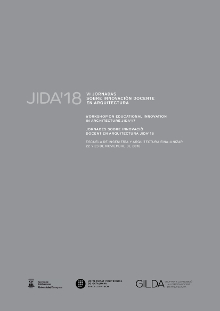Educando a la nueva generación de arquitectos: de las TICs a las TEPs
DOI:
https://doi.org/10.5821/jida.2018.5451Resumen
En la última década, la capacidad de gestión, almacenamiento y difusión de las tecnologías digitales ha hecho posible que los estudios de arquitectura puedan disponer de estructuras de comunicación y trabajo más dinámicas. Ante el reto de formar a profesionales digitalmente capacitados, las escuelas de arquitectura han incorporado progresivamente las TIC en los Talleres de Arquitectura. Su implementación ha desencadenado un proceso donde se ha pasado de enseñar por medio de las TIC a aprender con las TAC. Por el momento, podemos afirmar que el modelo educativo de Taller de Arquitectura donde se integran las TAC sigue, al igual que la práctica profesional, en transformación. Por tanto, a medida que dichos cambios van produciéndose, las escuelas están introduciendo modificaciones en el Taller de Arquitectura. Teniendo esto en cuenta, podemos aventurar que su futuro parece encaminarse hacia la inclusión de las TEP como entornos de aprendizaje participativos y de empoderamiento.
Citas
ARMSTRONG, G., and VANNER, A. (2013) “#Twittercritter: Extending the Reach of Studioâ€. In: AAE International Conference on Architectural Education: (un) common currency (03-05.04. 2016. Nottingham). Nottingham: Nottingham Trent University and Association of Architectural Educators. 131-134.
BAUTISTA SANCHO, L. (2012). “Los cambios en la web 2.0: una nueva sociabilidad†en Estudios sobre el Mensaje PeriodÃstico, vol. 18, special issue, p. 121-128.
BROWN, J.S. and DUGUID, P. (2002). The Social Life of Information. Cambridge: Harvard Buseness School Press.
CASTELLS, M. (2000). “Internet y la sociedad red†in Conferencia de Presentación del Programa de Doctorado sobre la Sociedad de la Información y el Conocimiento. Universitat Oberta de Catalunya. Available in < http://www.uoc.edu/web/cat/articles/castells/print.html > [Accessed: 06 August 2018]
EARL, A., O’COILL, C. and WIN, J. (2008). “Virtual Studio: a Digital Repository in Architecture Education†in Zambelli, M., Janowiak, A. H., Neuckermans, H. Browsing Architecture. Metadata and Beyond. Stuttgart: Fraunhofer IRB Verlag.
FLORIDA, R. L. (2002). The Rise of the Creative Class: and How it’s transforming Work, Leisure, Community and Everyday Life. New York: Basic Books.
GRIERSON, H. (2004). “The Internet as a Tool for Communication in Design Project†in CEBE Transactions, vol. 1, issue 2, p. 77-90.
LÉVY, P. (1994). L’Intelligence collective. Pour une anthropologie du cyberespace. Paris: La Découverte.
MAHER, M. L., SIMEON, J. S. and CICOGNANI, A. (1999). Understanding Virtual Design Studio. Berlin: Springer-Verlag.
MAO, I. (2008). Sharism: A Mind Revolution. < https://freesouls.cc/essays/07-isaac-mao-sharism.html> [Accessed: 20 August 2018]
MASDÉU BERNAT, M. (2017). La transformación del Taller de Arquitectura en nuevos espacios de aprendizaje. Un estudio sobre el proceso de integración entre la enseñanza y la práctica profesional. Thesis. Girona: Universitat de Girona, < https://www.tesisenred.net/handle/10803/482043> [Accessed: 06 August 2018]
O’REILLY, T. The Architecture of Participation. < https://perma.cc/M7TH-EVBN> [Accessed: 16 August 2018]
PINK, D. H. (2008). Una nueva mente: una fórmula infalible para triunfar en el mundo que se avecina. Ilustrae.com.
REIG, D. (2012). SocionomÃa. ¿Vas a perderte la revolución social?. Barcelona: Deusto.
REIG, D. and VÃLCHEZ, L.F. (2013). Los jóvenes en la era de la hiperconectividad. Tendencias, claves y miradas. Madrid: Fundación Telefónica.
RUIZ-JARAMILLO, J., ALBA-DORADO, M. I., CIMADOMO, G., JIMÉNEZ-MORALES, E. and JOYANES-DÃAZ, M.D. (2016) “TIC+ABP: dos instrumentos para la innovación docente en Arquitecturaâ€. GarcÃa-Escudero, D., BardÃ-Milà , B. y Domingo Calabui, D. (ed.) In: JIDA’16. IV Jornadas de Innovación Docente en Arquitectura (20-21.10. 2016. Valencia). Barcelona: Editorial Universitat Politècnica de València and Iniciativa Digital Politècnica UPC. 387-396.
SIEMENS, G. (2010). “Conectivismo: Una teorÃa de aprendizaje para la era digital†in Aparici, R. (ed.). Conectados en el ciberespacio. Madrid: Ed. UNED.
SPIGAI, V., CONDOTTA, M. and STEFANELLI, C. (206) “Collaborative E-Learning in Engineering and Architecture: Intelligent Systems for Knowledge Sharing in On-line Design Laboratoriesâ€. In: Joint International Conference on Computing and Decision Making in Civil and Building Engineering. Montreal. 1082-1091.
SUNSTEIN, C. R. (2006). Infotopia: How Many Minds Produce Knowledge. Oxford: Oxford University Press.
VIGOTSKY, L. S. (1978). Mind in Society. The Development of Higher Psychological Processes. Massachusetts: Harvard University Press.
WOJTOWICZ, J. (1995). Virtual Design Studio. Hong Kong: Hong Kong University Press.






















